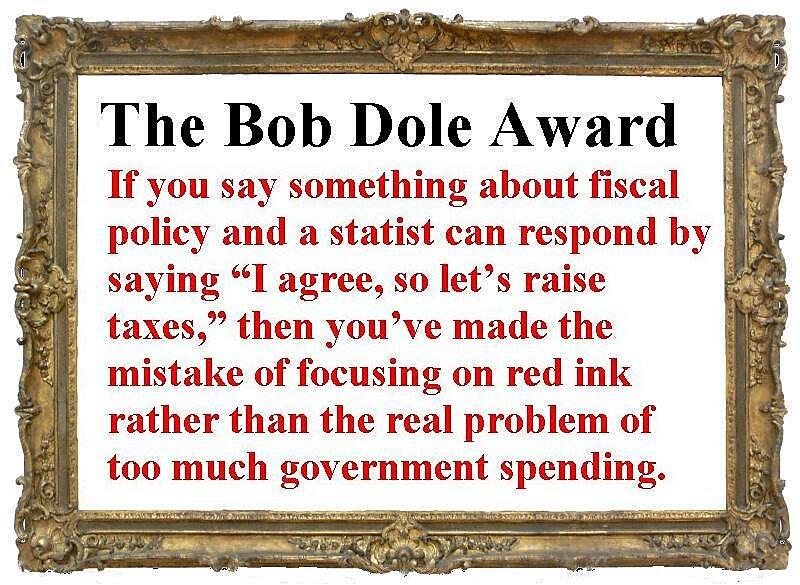Everyone has a cross to bear in life, some sort of burden or obligation, often self-imposed.
For some inexplicable reason, I’ve decided that one of my responsibilities is to educate a backwards and primitive people who seem impervious to common sense, simple logic, and strong principles.
As you’ve probably guessed already, I’m talking about Republicans.
I’ve already identified them at the Stupid Party, but they seem especially ill-informed and clueless on the topic of government borrowing.
I’ve specifically warned that they are economically (and politically) misguided when they focus on deficits and debt as America’s main fiscal problem.
I even created a “Bob Dole Award” in hopes of getting this point across. Simply stated, fixating on debt opens the door for higher taxes.
And does anyone think our economy would be stronger, or our fiscal position would be better, if we replaced some debt-financed spending with some spending financed by class-warfare taxes?
Especially since the higher taxes almost certainly would trigger more spending, so government borrowing would stay the same and the only thing that would change is that we’d be saddled with even more waste.
Notwithstanding all my educational efforts, Republicans couldn’t resist jumping up and down and making loud noises earlier this week when the national debt hit the $16 trillion mark earlier this week (a google search for “$16 trillion debt” returned more than 24 million hits).
So let’s walk through (again) why this is misguided.
First, let’s clear up some numbers that cause confusion. Republicans are complaining about something called the “gross federal debt.” This number is largely meaningless (see table 7.1 of the OMB Historical Tables if you want to look at the details).
It is the combination of a somewhat meaningful number of more than $11 trillion known as “debt held by the public,” which is a measure of how much the federal government has borrowed over time from the private sector, and a totally irrelevant number of about $4.5 trillion known as “debt held by federal government accounts.”
The latter number is simply a total of the IOUs that the government issues to itself, most notably the ones at the Social Security Trust Fund. But the “assets” in the Trust Fund at the Social Security Administration are offset by the “liabilities” at the Treasury Department. This is an empty bookkeeping gimmick, just as if you took a dollar out of your right pocket, put it in your left pocket, and left an IOU in exchange.
That being said, it is important to recognize that politicians have imposed poorly designed entitlement programs, and future spending on these programs will skyrocket far beyond current revenues. That growing gap, which is explained in this short video, is sometimes known as “unfunded liabilities.”
This number depends on a whole range of assumptions and can be measured in current dollars, constant dollars, and present value. I prefer the middle approach, which adjusts for inflation, and it’s worth noting that “unfunded liabilities” for Social Security and Medicare are more than $100 trillion.
That’s a number we should worry about, not the make-believe $4.5 trillion of IOUs that comprise part of the “gross national debt.”
Now let’s get to the most important issue. The reason we should worry about that $100 trillion number is that it is an estimate of how much the burden of spending will climb in the future. That additional spending will weaken the economy whether it is financed by borrowing or taxes.
Sort of helps to explain why entitlement reform is completely necessary if we want to keep America from a Greek-style fiscal collapse at some point in the future.
Here’s my video on the topic. In an ideal world, Republicans would not be allowed to talk about fiscal policy until they were first strapped in chairs, given a bunch of ADD medicine, and forced to watch this on automatic replay about 50 times.
Now for the all-important caveats. Yes, a nation can reach a point where debt becomes a problem. All you have to do is look at the mess in Europe to understand that point.
And I’ve shared numbers from both the Bank for International Settlements and the Organization for Economic Cooperation and Development to indicate that almost all nations – including the U.S. – are going to face similar problems if government policy is left on autopilot.
What I want people to realize, though, is that governments only get into that kind of mess because there’s too much spending.
Government spending is the disease. The various ways of financing that spending – taxes, borrowing, and printing money – are symptoms of the underlying disease.

